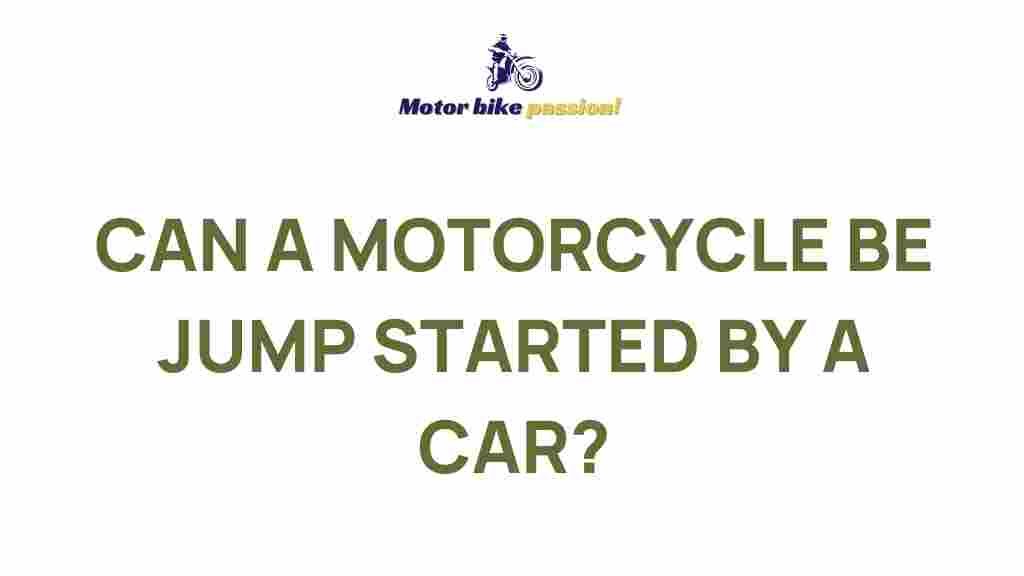Jump Starting a Motorcycle with a Car
Finding yourself stranded with a dead motorcycle battery can be a frustrating experience. Whether you’re miles away from home or just late for work, knowing how to jump-start your motorcycle can be a lifesaver. One unconventional yet practical solution involves using a car. In this guide, we’ll walk you through a safe and effective way to jump-start a motorcycle using a car.
Before diving into the step-by-step process, we’ll also discuss the tools you’ll need, potential risks, and how to troubleshoot any issues that may arise. By the end, you’ll feel confident enough to tackle this task should the need ever arise.
Why Would You Need to Jump Start a Motorcycle?
Motorcycle batteries can lose charge for several reasons, such as:
- Leaving the lights on while the engine is off.
- Cold weather causing battery drainage.
- Aging or faulty battery components.
- Irregular riding patterns that prevent proper battery charging.
If your motorcycle battery dies, jump-starting can serve as a quick fix until you can address the underlying issue.
Essential Tools and Preparations
To jump-start a motorcycle with a car, you’ll need the following:
- A pair of jumper cables.
- A functioning car with a 12-volt battery.
- Protective gloves (optional but recommended).
It’s important to ensure the car and motorcycle batteries share similar voltage. Most motorcycles also operate on 12-volt systems, but double-check your user manual to avoid potential damage.
Step-by-Step Process to Jump Start a Motorcycle
Step 1: Positioning the Car and Motorcycle
Park the car and motorcycle close enough for the jumper cables to reach both batteries. Turn off the car engine and ensure both vehicles are in neutral or park. Avoid letting the two vehicles touch during this process to prevent accidental grounding.
Step 2: Connecting the Jumper Cables
- Attach the red (positive) clamp to the positive terminal of the motorcycle battery.
- Connect the other end of the red clamp to the positive terminal of the car battery.
- Next, attach the black (negative) clamp to the negative terminal of the car battery.
- Secure the other black clamp to an unpainted metal surface on the motorcycle (preferably the frame) to ground the circuit.
Important: Do not attach the negative clamp directly to the motorcycle battery, as this can cause sparks or battery damage.
Step 3: Starting the Car
Turn on the car and let it idle for a minute or two. This allows the car battery to transfer some charge to the motorcycle battery.
Step 4: Starting the Motorcycle
Attempt to start the motorcycle. If it doesn’t start immediately, wait another minute before trying again. Once the engine turns over, allow the motorcycle to run for a few minutes to stabilize the charge.
Step 5: Disconnecting the Cables
- Remove the black (negative) clamp from the motorcycle’s grounding point.
- Detach the other black clamp from the car battery.
- Disconnect the red (positive) clamp from the motorcycle battery.
- Finally, remove the remaining red clamp from the car battery.
Store the jumper cables safely and let your motorcycle run for at least 20 minutes to recharge the battery fully.
Troubleshooting Common Issues
The Motorcycle Won’t Start
If your motorcycle doesn’t start after jump-starting:
- Check the connections. Ensure all clamps are securely attached and in the correct order.
- Verify the car battery’s charge. If the car battery is low, it may not provide enough power.
- Inspect the motorcycle battery for visible damage or corrosion.
Sparks or Smoke During Connection
Sparks can occur if you attach clamps in the wrong sequence or if the batteries are incompatible. Always double-check the polarity and ensure a proper ground connection.
Battery Fails Again Quickly
If your motorcycle battery dies again shortly after jump-starting, it may indicate a deeper problem, such as:
- A failing alternator or charging system.
- A battery nearing the end of its lifespan.
- Electrical components drawing excessive power.
In such cases, have your motorcycle inspected by a professional technician.
Safety Tips to Keep in Mind
While jump-starting a motorcycle with a car is generally safe, following these precautions can help you avoid potential hazards:
- Never allow the jumper cables to touch each other during use.
- Wear protective gloves to prevent accidental shocks.
- Avoid jump-starting a frozen battery, as it could rupture.
- Follow the recommended sequence for attaching and removing cables.
When to Seek Professional Help
If you’re unable to jump-start your motorcycle despite following the steps above, it’s best to consult a professional. Persistent battery issues might require a replacement or repairs to your electrical system.
For additional tips on maintaining your motorcycle, check out our motorcycle maintenance guide. You can also explore external resources like Rider’s Domain for more insights.
Conclusion
Learning how to jump-start a motorcycle with a car can be a valuable skill for any rider. By following the step-by-step instructions outlined in this guide, you can safely revive your motorcycle battery and get back on the road. Remember to practice proper safety measures and address any recurring issues promptly.
Keep this guide bookmarked or share it with fellow riders who might find themselves in a similar situation. With the right preparation, you’ll never let a dead motorcycle battery derail your plans!
This article is in the category Basic Guides and created by MotorBikePassion Team
